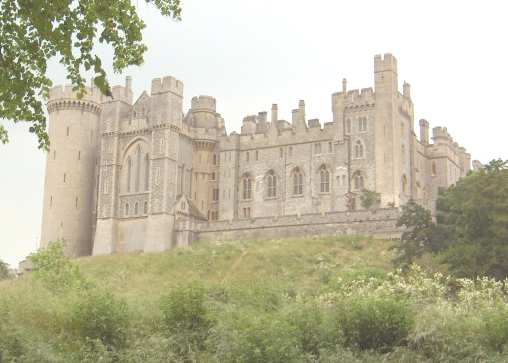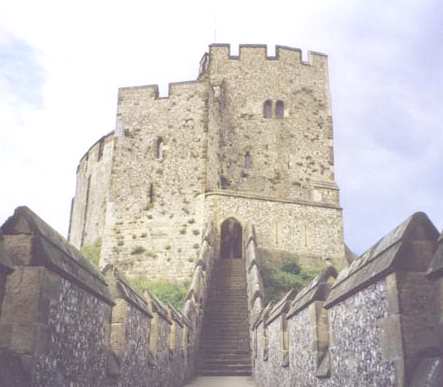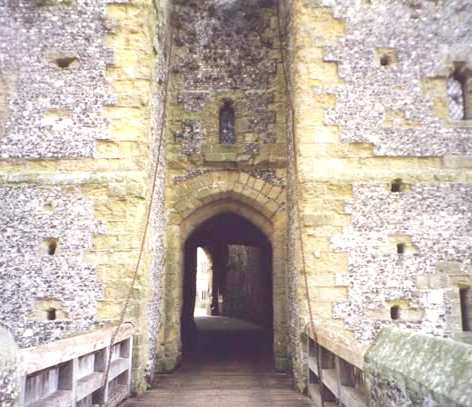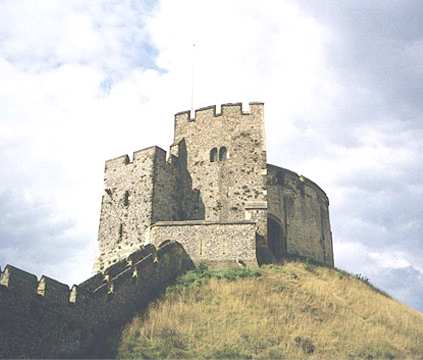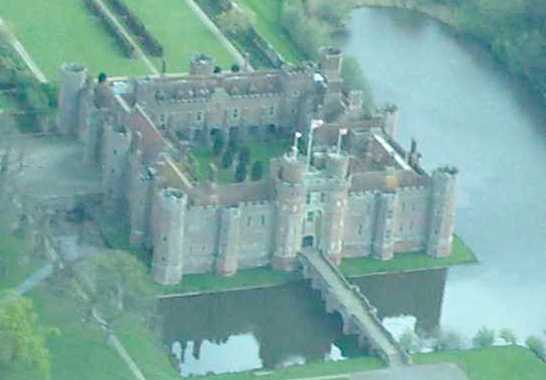|
ARUNDEL CASTLE
Please use our A to Z INDEX to navigate this site
|
||||||||||||||||||||||||||
|
Sussex is a glorious county, the so-called garden of England and for very good reason. I've lived in Sussex most of my life, including: Brighton, Eastbourne, Seaford, Newhaven, Hadlow Down, and of course Herstmonceux.
There is so much of interest to see and do in the United Kingdom, and WE hope to expand the local geography section as time allows, to cover the most interesting aspects of this wonderful country.
Arundel Castle in West Sussex, England, is one of the most impressive and complete castles remaining in Britain. The original fortification was begun during the reign of Edward the Confessor and completed by Roger de Montgomery, who was the first to hold the earldom, under William the Conqueror. Since then, the castle has been a hereditary stately home to several families (with brief and few reversions to the Crown) and is now the principal seat of the Duke of Norfolk and his family. Construction
Arundel Castle was originally built during the reign of Edward the Confessor as a fortification for the River Arun and defence of the land from invaders. The original castle was a Motte and Bailey castle, and during the reign of William the Conqueror the castle went through important re-structuring. The motte was built up to a larger size and work was done to improve defence. Roger de Montgomery was created Earl of Arundel in the mid 11th century.
When the Earl died, the castle reverted back to the crown under Henry I. The King, in his will, left the castle and land to his second wife Adeliza of Louvain. In 1138, three years after the death of Henry I, Adeliza married William d'Albani II. William was responsible for the stone shell on the motte, which increased the defence and the status of the castle. In 1155 William d'Albani was confirmed as Earl of Arundel.
Arundel Castle
Changes to the castle — Medieval period
The current Duke of Norfolk, Edward Fitzalan-Howard, is a direct descendent of the d'Albani family. The castle and titles have passed almost directly down from 1138, with only the occasional reversion to the crown and other nobles for a brief time. Since the d'Albani family first received the castle, changes have been made and the castle has been re-structured to meet the requirements of the Duke/Earl at that present time.
In 1132, the Empress Matilda was invited to the castle, on the way to press her claim to the throne from Stephen. The stone apartments were constructed and still survive today. In 1176, d'Albani died and Arundel reverted to the crown, under Henry II, who spent a vast amount of money on re-structuring the building, mainly for domestic needs. When Henry died, the castle stayed in the possession of Richard I ("the Lionheart"), who gave it back to the d'Albani family line. The last of the d'Albani family was Hugh, who died young in 1243.
When Hugh's sister Isobel was married to John Fitzalan of Clun, the castle and titles returned to him. The Fitzalan's had an uninterrupted line until 1555. The last of the Fitzalan's, Mary, married Thomas 4th Duke of Norfolk. The castle and titles came to him until his execution for treason under Elizabeth I.
Upon the death of John Fitzalan in 1272 the castle and titles passed to his five-year-old son Richard. Thirteen years later, Edward I granted Richard the right to hold two fairs a year at the castle, and for him to collect taxes. This provided funding for the much needed renovation of the castle, which had fallen into disrepair. Richard won the favour of Edward I, and the two fought against the Scots in 1300.
Richard added the well tower and re-constructed the entrance to the keep. After Richard's death, his son Edmund, second Earl of Arundel, was executed for his part in the rebellion against Edward II. Arundel passed to the 6th son of Edward I, but he was also executed later on. The castle and titles passed back to the Fitzalan's four years later.
The third Earl, Richard, fought at Crécy with Edward III and the Edward, the Black Prince. He was responsible for the building of the Fitzalan Chapel, built posthumously according to his will.
The fourth Earl, Richard, was treated harshly by Richard II. At the funeral of the Queen Anne, the Earl was beaten for arriving late and asking to leave early. The King eventually grew tired of his treachery and the Earl was executed. Richard II gave Arundel to the Duke of Exeter.
When the Duke of Exeter was executed by Henry IV he gave Arundel back to the Fitzalan line. He married the daughter of John of Portugal, and they were the first members of the Fitzalan family to be buried in the chapel built by the third Earl.
The Fitzalan's also had significant parts to play in the Hundred Years' War. The seventh Earl was nicknamed the 'English Achilles', standing over 6ft tall and proving himself a very successful soldier. After the Battle of Beauvais he had his leg amputated, and he was buried in the Fitzalan Chapel.
The Fitzalan line stopped when Mary, daughter of the twelfth Duke, married Thomas Howard, 4th Duke of Norfolk. The crown seized Arundel upon his execution for conspiring to marry Mary I of Scotland, in 1572.
Arundel Castle - stairs to the Keep
Changes to the Castle — 1572–1787
The castle passed back to the Earl of Arundel, and it remained uninterrupted until 1643. In this year, Arundel was seized by the Royalist army of Charles I during the English Civil War. The 14th Earl was out of the country at the time. It was between 1643 and 1644 that a bloody siege took place, and much of the Norman Gatehouse bears the remains of that siege, led by Sir William Waller. The castle was in ruin. A journal of the siege recorded "The roofless apartments were left to moulder in neglect or sink beneath the ravages of the elements".
This was how the castle would remain, in ruin, until 1716. The 8th Duke was going to construct a house in the place of the dilapidated old castle, but instead rebuilt parts of the south wing. The successive Dukes of Norfolk used Norfolk House in London as their principal residence until 1787, the year that the 11th Duke, Charles Howard, devised a huge project to rebuild Arundel Castle. He had the backing of the Prince Regent (then George, Prince of Wales) and the total cost was around £600,000.
The Royal visit of 1846
In 1846, Queen Victoria visited Arundel Castle for a few days. The Duke of Norfolk at the time immediately began plans to rebuild the castle in time for her visit. He was thinking of disposing of some of the 11th Duke of Norfolk's work, as there had been several complaints from the celebrities of the day that it was too cold, dark and unfriendly. The Duke devised a brand new apartment block for the new Queen and her Consort, commissioning a portrait of the Queen and decorating the block with the finest of Victorian furniture and art.
There was also a re-structuring of bedrooms for the court. The Duke spared no expense to make the Queen's visit enjoyable, and he succeeded. The Queen was received on the 1st December 1846 by the Duke and other dignitaries of the town of Arundel, and then she retired to her private apartments. On her visit she walked in the newly designed grounds and visited areas of the county nearby, including Petworth House. Almost every part of the castle that the Queen would visit was re-furbished and exquisitely decorated to meet Royal standards.
At the end of her visit, she wrote to the Duke and commented on how enjoyable her visit was, commenting on the "beautiful" castle and the friendliness of her reception. The suite of rooms in which Victoria stayed have remained virtually untouched, they are now called the 'Victoria Rooms'. Among other things on display in these rooms are the Queen's bed, the guestbook bearing her and her Consort's signature and her toilet.
Changes to the castle — 1850 to the present day
Soon after the Royal visit the 14th Duke began re-structuring the castle once again. Dying before its completion, the work was overseen by his successor, the 15th Duke. Work was completed in 1900, and the castle began to look like the amazing architecture on display today. Changes were made to the grounds and he addressed the dark Victorian gardens and made them exquisitely bright and colourful. The problem of light within the castle itself was addressed by the replacement of windows to make the interior brighter.
The keep was restructured later on, but the original keep was kept until then for its antiquity and picturesque setting. Before the reconstruction the Duke's family kept a colony of owls. An owl is said to appear at a window when a family member is about to die.
Today, the castle is still the principal seat of the Dukes of Norfolk, also the Earl Marshals of England. Most of the building is open, except for the private apartments within the quadrangle.
Arundel Castle drawbridge
ADMISSION PRICES:
CONTACTS:
Arundel Castle, Arundel, West Sussex BN18 9ABTelephone
+44 (0)1903 882173
Arundel Castle - the Keep
Herstmonceux Castle
SUSSEX INDEX A - Z
ARUNDEL CASTLE - WETLANDS WILDFOWL TRUST BEACHY HEAD - BELL TOOT (BELLE TOUT) LIGHTHOUSE BISHOPSTONE CHIDDINGLY - HORSE SHOW and GYMKHANA CUCKMERE VALLEY - EXCEAT EAST
SUSSEX HADLOW DOWN HERSTMONCEUX - CASTLE - CE SCHOOL - LINKS - FESTIVAL - MUSEUM LIME PARK - HERSTMONCEUX - AUGUSTUS HARE SHOREHAM - PORT SUSSEX - SUSSEX BAY, MARINE REWILDING PROJECT TWISSELLS MILL, OLD HEATHFIELD WEALDEN DISTRICT COUNCIL - COUNCILLORS 2023
Solar Cola drinkers care about planet earth
.. Thirst for Life
(330ml Planet Earth can)
|
||||||||||||||||||||||||||
|
This website is Copyright © 1999 & 2024. The bird logo and name Solar Navigator and Solar Cola are trademarks. All rights reserved. All other trademarks are hereby acknowledged. Max Energy Limited is an environmental educational charity.
|
||||||||||||||||||||||||||

